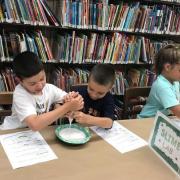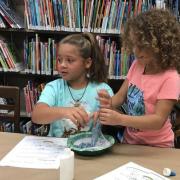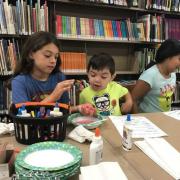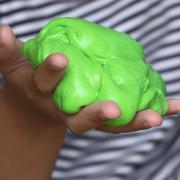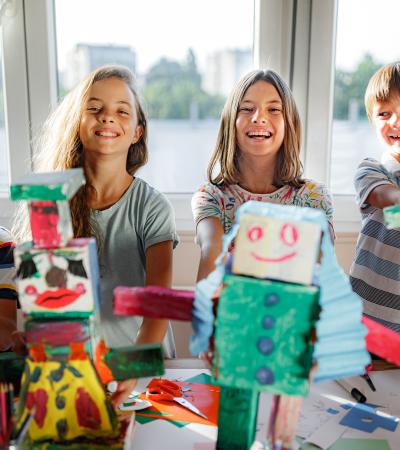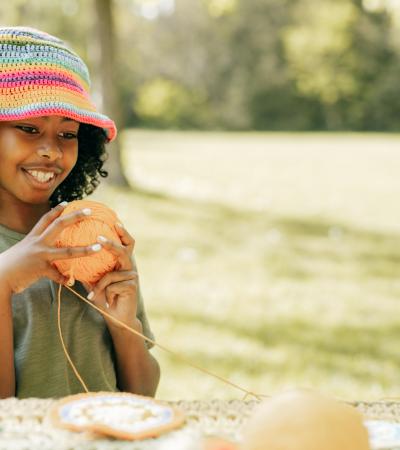Our How to Make Slime program gave students the opportunity to use common household ingredients to create their own slime.
They practiced skills including reading recipes, measuring, mixing colors and trial and error to make a colorful, slimy substance that they then played with and took home.
Advanced Planning
Our goals for the program were to engage children in a fun library activity while also challenging them to experiment with our slime concoction. It touched upon STEM skills like measuring and experimenting, and challenged participants to practice their reading and art skills, as the children mixed primary colors to create their desired final slime color.
We began planning the programs in our summer Learn How To and Maker Monday series — of which How to Make Slime was one — at the beginning of the summer. Our youth services librarian was the main person involved in planning and organizing the event. She researched recipes, experimented with a few of the different options, chose a combination of ingredients that worked best and then purchased the supplies. (View the slime recipe under Attachments).
We scheduled the How to Make Slime program for 10 a.m. on Friday, July 14, 2017.
Marketing
We advertised this program in a pamphlet that we distributed in all the children’s welcome bags for the Summer Reading Program, as well as at a local township concert that occurred shortly before the event.
We also displayed fliers for the program around the library as well as posting it on social media platforms including various local Facebook groups and the library’s website. (View the flier under Attachments).
Our marketing efforts were successful; we had a good-sized group of children of varying ages who came to participate in our event. We also caught the attention of the local media with our advertising, and a reporter from NorthJersey.com came to cover the event.
Budgeting
We spent a minimal amount of money (approximately $25) on this program. We purchased the basic ingredients including baking soda, white school glue, contact lens solution, glitter and food coloring.
We already had the other items that we needed on hand, like bowls and spoons for mixing the slime, as well as brown craft paper to cover the tables.
Day-of-event Activity
On the day of the event two staff members set up the Slime Lab area. We covered the tables with brown craft paper, set out bowls and spoons for each participant, set out the ingredients at the head of the table, and put up the Slime Lab posters. (View the Slime Lab poster under Attachments).
We set up 30 minutes before the program started and distributed copies of the recipe at the beginning of the program.
Program Execution
The program began with a quick introduction to the activity. We read the recipe together as a group, modeled how to properly use our measuring tools to portion out our ingredients, and discussed the meaning of “trial and error” so the children would feel comfortable experimenting with the ingredients if they felt like their slime needed tweaking along the way. Then we began mixing!
Once we started mixing, the staff members assisted the young slime creators by helping each pair of children measure out their ingredients. The staff circulated around the table as the children mixed and offered advice while also encouraging them to try out different mixtures on their own to perfect their preferred slimy texture and color.
Twenty-five children attended the event, accompanied by their parents and guardians. The feedback was overwhelmingly positive. Many of the children asked if we could repeat the program again in the future, and many parents thanked us for running the program, as their sons and daughters thoroughly enjoyed the activity. (See photos of kids in the Slime Lab under Photo Slideshow).
Our Learn How to Make Slime program kicked off two of our series of children’s summer programming: the Learn How To series and the Maker Monday series. The success of this event sparked an interest in all of our upcoming programs, including many programs based on STEM concepts, such as Building Marble Roller Coasters, Making Bubbles, Constructing a Cardboard Town and Making Homemade Fidget Spinners. More and more patrons attended our programs each week, and we heard many stories of families who left the library and then continued our projects at home. Our slime program certainly helped to ignite creativity and encourage our families to explore STEM projects on their own.
Advice
This program is a great way to get children of different ages involved together in a fun activity at the library. It is important to constantly remind the participants that they need to utilize trial and error while they work. For instance, if their slime is too sticky, dry or watery, they can add more of selected ingredients. They need to feel free to keep trying different things until something works for them.
In addition, the children love experimenting with unique ways to personalize their slime. In addition to food coloring and glitter, it might be fun to offer other additions like small pom-poms, water beads or glow-in-the-dark paint.

